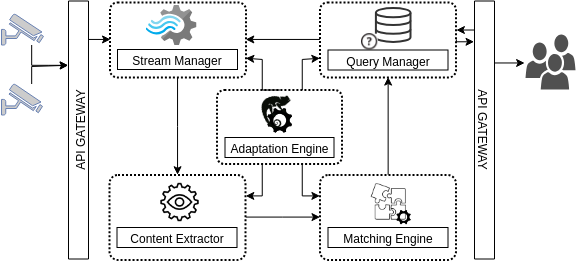Being a distributed event processing framework, GNOSIS needs to handle the necessary related requirements. However, in this situation where different components are interacting and reacting to changes of each other, we arrive at the problem that complex systems are generally hard to maintain, deploy, scale and therefore they tend to cost more [1]. Thus they require a good and compatible software architecture model.
On another note, we can see that microservices architecture (MSA) is one of the new trends in distributed systems architecture [2], they are still on the rise and been used by big companies such as Netflix, Amazon, Uber, and others [4], and are generally seen as a good solution for the overall problems of complex systems. Because of this, Gnosis implements the microservices architectural principle, with respect to its best practices, paying detailed attention to common architectural smells [4], as well as problems specific to a distributed Multimedia Event Processing context.
Framework Design

sub-domain decomposition approach.
Our main approach for defining the boundaries of our microservices was to use a Domain Driven Design (DDD) decomposition [3] and to improve over multiple development iterations. In this type of decomposition, we identify the main sub-domains of our framework and used them to define the initial borders of each service. Following this, we developed a simple artifact that would meet this architecture, within a small development time frame. During each one of these development cycles, we would identify some services that were clearly overloaded with responsibilities and needed to be broken down into other microservices according to their respective sub-domains.
Figure 1 shows the main subdomains derived from this decomposition. Each one of these subdomains contains multiple microservices and the general purpose for each sub-domain is as follows:
- API Gateway Connection of external entities, such as subscribers and publishers
- Query Manager Parsing, maintaining, optimising and planning the available user queries
- Stream Manager Pre-processing of publisher streams, scheduling and dispatching events
- Content Extraction DNN-models for extracting features into VEKG graphs from the video streams
- Matching Engine Manages the match of VEKG graphs streams with the users’ queries
- Adaptation Engine Incorporates self-adaptive behaviour into the system by using the MAPE-K architecture
Benefits and Disadvantages
As of any architectural choice, using MSA has its own benefits and disadvantages on a Distributed MEP system.
Benefits
For Gnosis, the main benefits of using microservices are the following:
- Fine Grained Services: Services that do very simple, well defined tasks, and work as independent as possible from others. This help out to have a clear understanding of the objective of each one of these individual pieces, as well ensuring that they work independently of the logic and implementation of the others.
- Autonomous Development, Deployment, Testing: Independence between microservices logic allows for the development of each of these small parts without the need to do changes do others. This autonomy encourages the pursuit of unit tests for each component and easy automation of the deployment pipeline during run-time of a new version of a microservice.
- Scalability: MSA makes scaling horizontally (replicating running instances of a service) more optimal, since instead of wasting resources scaling all of the system, as would be the case in a monolithic architecture, it can scale only the parts that are requiring more processing power, e.g: a bottle-neck microservice in the system. It also does not restrict the use of vertical scaling (increase computational resources, such as CPU, memory, etc.).
- Distributed: Because of the decoupled and autonomous nature of it’s parts, MSA is a good base for distributed systems, making it possible to take advantage of most cloud-like infrastructures, which are distributed by design.
- Lightweight Communication: Ensure that the components are easily replaceable, without adding much cost on refactoring the whole systems and it’s underlying communication layer.
Disadvantages
The main disadvantages of using MSA in our framework are the following:
- Intercommunication Latency As with most distributed architectures, it is important to take care with synchronous and slow protocols such as HTTP, and to bare in mind the necessity of a schemaless message serialisation (e.g: Json or Messagepack) because of the unstructured nature of media streams data representation.
- Security MSA spreads the responsibility of security to all the different parts of the system, which means that it is necessary to ensure that all services are safeguarded, and that the inter-communication between parts and stored data are encrypted and secure. And since encrypting and decrypting messages require more processing time in comparison to using plain images, this creates a trade-off between security and speed, which is a big issue on a real-time system.
- Smells and anti-patterns MSA has some common architecture mistakes and anti-patters (known as architecture smells). But some of this smells have different importance in the MEP context, which requires special care and attention during the architecture design decisions.
- Services Monitoring Monitoring in distributed systems tends to be harder in general, and in MSA this is a known weakness. This is even more important on a self-adaptive framework, such as Gnosis, that relies on a good monitoring to ensure it’s adaptation strategies.
References
[1] Sidney Dekker, Erik Hollnagel, David Woods, and Richard Cook. Resilience engineering: New directions for measuring and maintaining safety in complex systems. Lund University School of Aviation, 2008.
[2] Pooyan Jamshidi, Claus Pahl, Nabor C Mendon¸ca, James Lewis, and Stefan Tilkov. Microservices: The journey so far and challenges ahead. IEEE Software, 35(3):24–35, 2018.
[3] Chris Richardson. Microservices patterns, 2018.
[4] Davide Taibi and Valentina Lenarduzzi. On the definition of microservice bad smells. IEEE Software, 35(3):56–62, 2018.